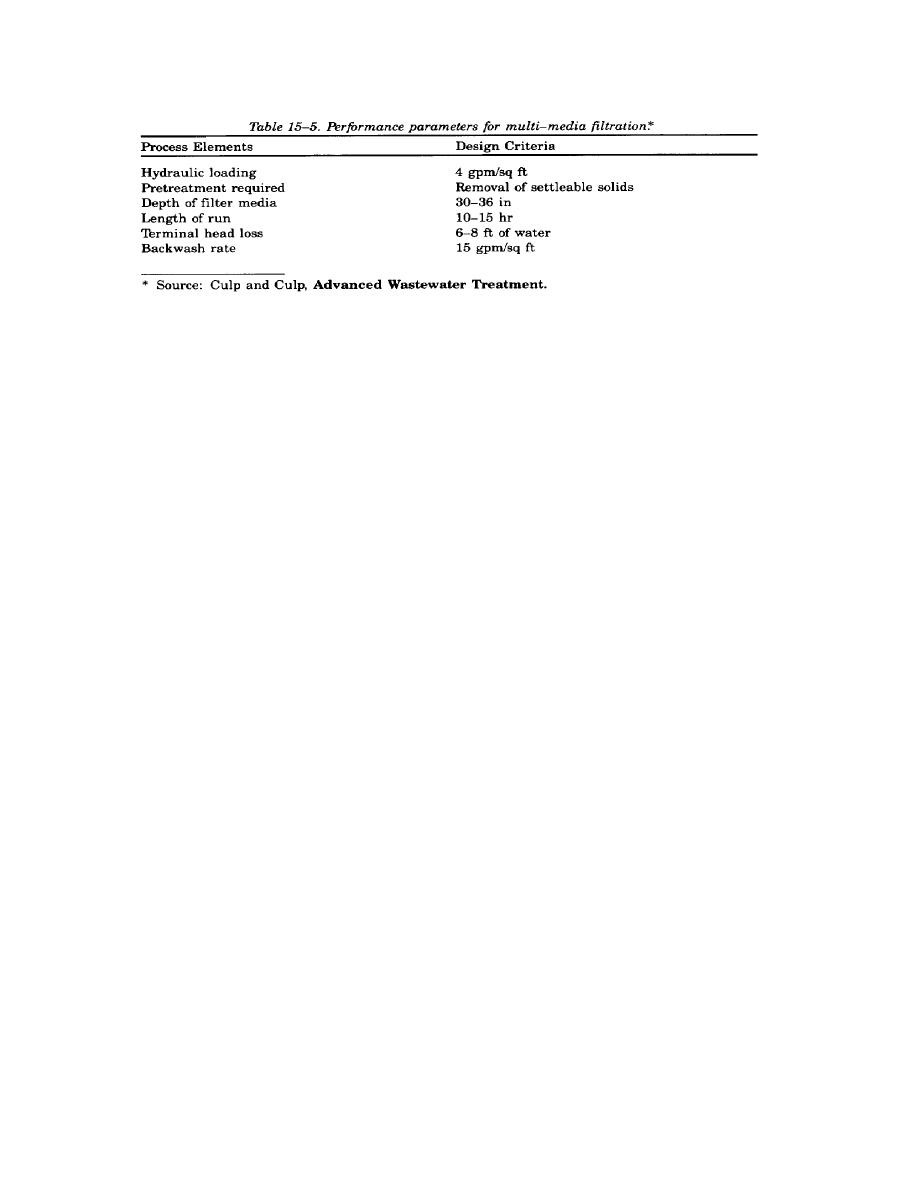
TM 5-814-3/AFM 88-11, Volume III
d. Upflow filtration. Upflow filtration utilizes a pressurized wastewater feed with flows in the upward
direc-tion. Upward flow overcomes the fine-to-coarse particle-size distribution disadvantage of single-media
filters. The media used is sand on top of gravel, with some models containing a grate on top of the sand layer
to keep it compacted during filtration. This type of filter will achieve an average suspended-solids removal
of 85 per- cent and is capable of higher solids loading than conventional filters. The maximum design filtration
rate will be 8 gallons per minute per square foot. Continuous upflow, air wash filters are also available.
e. Filter washing. All filters, with the exception of the upflow type, will require a reverse flow or
backwash rate of 15 gallons per minute per square foot. An increased application or forward wash rate of
25 gallons per minute per square foot will be used for upflow filters. The required design duration of the wash
cycle will be 8 minutes. The source of wash water in sewage filtration applications will be filter effluent or
chemically coagulated and settled effluent rather than secondary effluent to ensure that the filter wash supply
will always be free of large quantities of suspended solids. A filter wash flow indicator should be included
so that the operator can be sure that the desired wash rate is being maintained at all times. The wasted wash
water must be reprocessed. Storage facilities will be provided with filter wash wastewater returning to
process at a controlled rate not to exceed 15 percent of the inflow. Provisions must be made to store the
incoming flow during the filter wash cycle or, if there are no parallel units, to increase the rate on the other
filters during the washing cycle. Either mechanical surface wash equipment or air scouring facilities will be
provided as part of the backwashing design considerations.
15-6. Activated carbon adsorption.
Use of activated carbon adsorption will be based on carbon column studies performed on the waste with the
type of carbon that is to be used in the operating process at the site proposed.
a. Process configurations.
(1) Downflow. When used in a downflow configuration, carbon adsorption beds will accomplish filtra-
tion as well as adsorption. This generally is an inefficient use of the activated carbon and will require frequent
backwashing. When the feedwater suspended solids concentration is greater than 50 to 65 milligrams per
liter, solids removal pretreatment must be provided. Downflow carbon adsorption processes operate at
hydraulic loadings of 2 to 10 gallons per minute per square foot of column cross-section area. The columns
must be maintained in an aerobic condition to prevent sulfide formation; this will be accomplished by
maintaining dissolved oxygen levels in feed and backwashing waters.
(2) Upflow. Upflow carbon adsorption can be operated in three different modes. At hydraulic loadings
less than 2 gallons per minute per square foot, the carbon bed remains packed at the bottom of the column,
providing filtration as well as adsorption. (This filtration can cause backwashing problems.) At hydraulic
loadings of 4 to 7 gallons per minute per square foot, the carbon is partially expanded and suspended solids
pass through the bed. At loadings greater than 7 gallons per minute per square foot, the carbon bed is lifted.
Upflow carbon beds are usually operated in the expanded-bed or partially expanded-bed mode and normally
require no backwashing. However, periodic backwashing is helpful in removing carbon fines. Post-filtration
will be provided to remove suspended solids from the effluent.
15-9



 Previous Page
Previous Page
